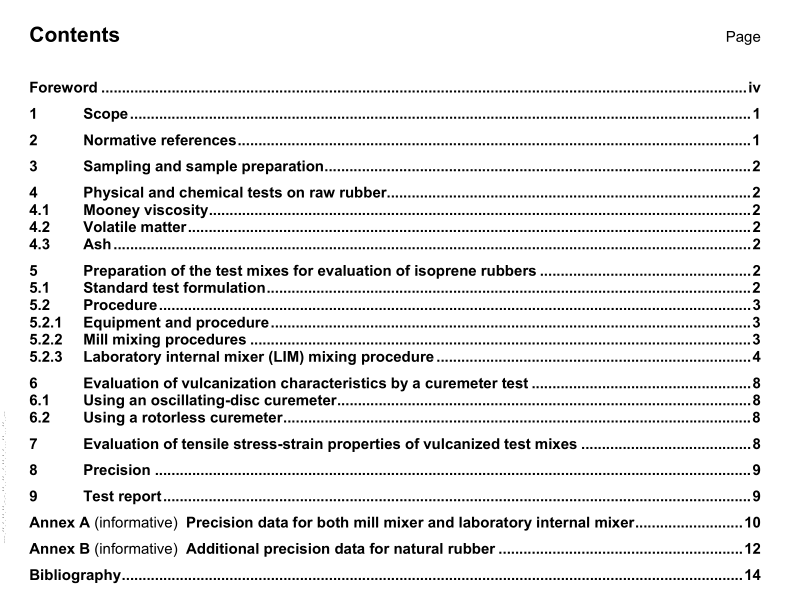ISO 2303 pdf download

ISO 2303 pdf download Isoprene rubber (IR) — Non-oil-extended, solution-polymerized types — Evaluation procedures
1 Scope
This International Standard specifies,for general-purpose non-oilextended,solution-polymerizedpolyisoprene rubbers (IR):
-physical and chemical tests on raw rubbers;
standard materials, a standard test formulation, equipment and processing methods for evaluating thevulcanization characteristics.
2Normative references
The following referenced documents are indispensable for the application of this document.For datedreferences,only the edition cited applies. For undated references,the latest edition of the referenceddocument (including any amendments) applies.
ISO 37, Rubber, vulcanized or thermoplastic—Determination of tensile stress-strain propertiesISO 247:2006,Rubber – Determination of ash
ISO 248-1,Rubber,raw—Determination of volatile-matter content— Part 1: Hot-mill method and ovenmethod
ISO 289-1,Rubber,unvulcanized – Determinations using a shearing-disc viscometer – Part 1:Determination of Mooney viscosity
ISO 1795, Rubber, raw natural and raw synthetic— Sampling and further preparative proceduresISo 2393,Rubber test mixes — Preparation, mixing and vulcanization —Equipment and proceduresISO 3417,Rubber —Measurement of vulcanization characteristics with the oscillating disc curemeterISO 6502,Rubber -Guide to the use of curemeters
ISO 23529,Rubber – General procedures for preparing and conditioning test pieces for physical testmethods
3 Sampling and sample preparation
3.1A laboratory sample of approximately 1,5 kg shall be taken by the method described in ISO 1795.3.2Preparation of the test portion shall be in accordance with ISO 1795.
4Physical and chemical tests on raw rubber
4.1 Mooney viscosity
The Mooney viscosity shall be determined in accordance with ISO 289-1 on a test portion prepared asdescribed in lSO 1795 (without massing).
The result shall be recorded as ML(1 + 4) at 100 °c.
4.2 Volatile matter
The volatile-matter content shall be determined in accordance with lSO 248-1.
4.3Ash
The ash content shall be determined in accordance with lSO 247.
5 Preparation of the test mixes for evaluation of isoprene rubbers5.1Standard test formulation
The standard test formulation is given in Table 1.
The materials shall be national or international standard reference materials. If no standard reference materialis available, the materials to be used shall be agreed by the interested parties.
5.2Procedure
5.2.1 Equipment and procedure
Equipment and procedure for the preparation, mixing and vulcanization shall be in accordance with ISO 2393.5.2.2 Mill mixing procedures
5.2.2.1 General
Two mill mixing procedures are specified: methods A and B. The mixing time is shorter in method B than inmethod A.
The two methods do not necessarily give identical results. In laboratory cross-checks or in a series ofevaluations, the same procedure shall be used in all cases.
In both methods, the standard laboratory mill batch mass, in grams, shall be based on four times the formulamass. The surface temperature of the rolls shall be maintained at 70 °C±5 °C throughout the mixing.
A good rolling bank at the nip of the rolls shall be maintained during mixing. if this is not obtained with the nipsettings specified in 5.2.2.2 and 5.2.2.3, small adjustments to the mill openings might be necessary.
5.2.2.2 Method A
Duration
a)Pass the rubber between the mill-rolls twice without banding, with the mill
opening set at 0,5 mm, for approximately 2 min and weigh the rubber.
b) Band the rubber with the mill opening set at 1,4 mm and make two 3/4
cuts from each side.
NOTE Some types of isoprene rubber go to the back roll, in which case the stearic acid should be added and, afterits incorporation, the rubber can usually be transferred to the front roll. In addition,certain tougher types of isoprenerubber might require slightly longer breakdown before the addition of other materials in order to obtain a good rolling bank.
c)Set the mill opening to 1,7 mm and add the stearic acid. Make one 3/4 cut
from each side.
d)Add the zinc oxide and the sulfur. Make two 3/4 cuts from each side.
e)Add the carbon black evenly across the mill at a uniform rate. When
approximately half the black has been incorporated, open the mill to1,9 mm and make one 3/4 cut from each side, then add the remainder ofthe carbon black.Be certain to add any black that has dropped into themill pan. When all the black has been incorporated,make one 3/4 cutfrom each side.









